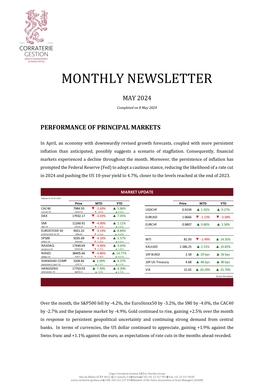1. PERFORMANCE OF PRINCIPAL MARKETS
In April, an economy with downwardly revised growth forecasts, coupled with more persistent inflation than anticipated, possibly suggests a scenario of stagflation. Consequently, financial markets experienced a decline throughout the month. Moreover, the persistence of inflation has prompted the Federal Reserve (Fed) to adopt a cautious stance, reducing the likelihood of a rate cut in 2024 and pushing the US 10-year yield to 4.7%, closer to the levels reached at the end of 2023.
Kindly refer to the link at the bottom of the page to view the table.
Over the month, the S&P500 fell by -4.2%, the EuroStoxx50 by -3.2%, the SMI by -4.0%, the CAC40 by -2.7% and the Japanese market by -4.9%. Gold continued to rise, gaining +2.5% over the month in response to persistent geopolitical uncertainty and continuing strong demand from central banks. In terms of currencies, the US dollar continued to appreciate, gaining +1.9% against the Swiss franc and +1.1% against the euro, as expectations of rate cuts in the months ahead receded.
2. ECONOMIC AND FINANCIAL ENVIRONMENT
In March, the US Consumer Price Index (CPI) increased by +0.4% monthly and by +3.5% year-on-year, compared with +3.2% in February. In addition, core inflation rose marginally for the third consecutive month, by +0.4% over the month and +3.7% over the year, pointing to potentially higher inflation in the longer term. Following this publication, Jerome Powell (Chairman of the FED) and some of his colleagues had no choice but to announce that they were waiting for a more favorable trend in prices before considering a rate cut, aiming to avoid repeating past mistakes. It should be noted that inflation above the central bank(s) target of 2% is not necessarily a problem as long as nominal growth turns out to be higher (i.e. real growth being positive). The real risk lies in a scenario of stagflation (high inflation and low economic growth), an environment that is dangerous for economic and financial stability.
The employment data for March seem to indicate an acceleration, with job creation excluding the agricultural sector (NFP) reaching +303’000, compared with +270’000 in February. The unemployment rate fell to 3.8%, while the employment participation rate rose to 62.7%. Once again, these statistics paint a picture of a flourishing labor market, although the pace of job creation is largely explained by a significant increase in part-time jobs at the expense of full-time positions. Finally, US gross domestic product (GDP) for the first quarter of 2024 shows growth of +1.6%, below expectations of +2.4%.
Despite the less favorable economic data, in particular lower-than-expected growth, the strength of the job market and persistent inflation have drastically reduced the likelihood of an interest rate cut by the Fed: whereas at the start of the year the consensus was for a total rate cut of 150 to 175 basis points (bps) in 2024, it now expects just 25 bps.
To date, the consensus scenario remains that of a "soft landing", or even a "no landing". A scenario supported by the excessive budgetary efforts deployed by the administration led by J. Biden and the acceleration in federal debt ($1,000bn per quarter) supported by the current Treasury Secretary J. Yellen ahead of the presidential election in November. In this particular environment, it is hardly surprising that inflation is struggling to continue its fall. Perhaps this is simply deliberate, since inflation is a means that requires little effort to limit growth or reduce the country's debt ratio.
3. OUR THOUGHTS AND ACTIONS
In the current environment, we maintain a neutral asset allocation, both in terms of exposure to risk assets and geographic distribution. At the same time, with the interest-rate hike cycle coming to an end and geopolitical tensions still very much alive, we are maintaining our exposure to short- and medium-term bonds of quality, as well as to gold and oil.
4. THEME OF THE MONTH: THE US ELECTIONS
In 2024, the calendar of government elections is particularly dense, involving the citizens of more than 64 countries, including India, Taiwan, the members of the European Union, and the United States. On 5 November 2024, Americans will be called upon to choose their next President for a four-year term. Although the official candidates will be chosen during the summer, the most likely candidates include the current President, Joe Biden, who will stand for re-election on behalf of the Democrats, and Donald Trump on behalf of the Republicans. This month we discuss the issues raised by the candidates, including: 1. Inflation and economic growth 2. The evolution of the budget deficit and the debt/GDP ratio. 3. The US-China trade war. 4. The outlook for taxes, and the potential impact of proposed policies on the real economy and financial markets.
First of all, let's take a step back to understand the structure of the US political system. Although it is multi-party, it is mainly dominated by two parties. On the one hand, we find the Democrats, who are generally associated with progressive values such as the promotion of civil rights, government intervention in social and economic issues, and environmental protection. On the other hand, Republicans are characterized by their support for conservative policies, traditional values, a pro-free market approach, and a focus on individual responsibility rather than government intervention. The presidential election is conducted by an indirect voting system, in which citizens choose the 538 members of the Electoral College (electors), who are then responsible for voting for the President and Vice-President. Once elected, the implementation of legislation depends mainly on the cooperation between the President and Congress, a bicameral system comprising the House of Representatives and the Senate. If the majority in both houses is not of the same party as the President, he is severely limited in his power to implement his party's vision. The election of these two chambers is therefore just as important as that of the President.
The 2024 election campaign appears to be a rematch of the 2020 campaign, even though the macroeconomic and political context is very different. To avoid speculating on future scenarios, let's focus instead on the actions taken by J. Biden during his term of office, and the candidates' vision for the next term.
First, let's look back at J. Biden's tenure. Inflation has emerged as a major challenge, and although inflationary pressures have eased from the 2022 peak, the real purchasing power of US consumers has eroded. In addition, the national debt has risen sharply, exceeding $34 trillion in March 2024, amplifying debt servicing costs to unsustainable levels. Nevertheless, two factors are positive: the unemployment rate has maintained a favorable trajectory, and economic growth has been more robust than expected, which has enabled the financial markets to post good performances, thanks incidentally to the enthusiasm for certain large companies.
D. Trump and J. Biden both share the goal of stimulating growth in the US economy, but their approaches differ significantly. Over the past four years, J. Biden has focused primarily on increasing government spending to support social programs such as student loan relief, reductions in bank fees (known as "junk fees") and massive initiatives to support renewable energy and infrastructure. This has had the effect of stimulating consumption but, as collateral damage, also inflation. On the other hand, D. Trump is seeking to continue the tax-cutting policy introduced by the “Tax Cuts and Jobs Act” during his first term in office, with the emphasis on tax cuts for the rich and businesses, also with the aim of stimulating economic growth, but in a different way to J. Biden's approach.
Despite these differences, the two candidates have several points in common. Firstly, they are aligned on trade policy towards China, with J. Biden having continued with the same determination the work undertaken by his rival D. Trump between 2016 and 2020. Furthermore, as far as monetary, and fiscal policy is concerned, whatever the outcome of the presidential election, in 2025, the room for maneuver seems limited and few differences are expected. Finally, under both Trump and Biden, the budget deficit has grown considerably and is forecast to continue to do so.
As far as the financial markets are concerned, historical data spanning more than 75 years shows that election periods have little effect on market performance over the medium to long term. What matters most is the state of the economy and inflation. However, a few points are worth highlighting: this year, changes in key rates by the Federal Reserve (FED), which cannot change its monetary policy in the two months preceding the elections, are likely to have a major impact on the markets. In addition, the data shows that certain sectors, such as defense, financials and small and mid-caps, seem to perform better under a Republican presidency, while healthcare and renewables seem to benefit from a Democratic presidency. In investment terms, however, our long-term convictions do not really change regardless of the outcome of the 2024 US elections.




